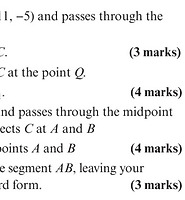| 일 | 월 | 화 | 수 | 목 | 금 | 토 |
|---|---|---|---|---|---|---|
| 1 | 2 | 3 | 4 | 5 | ||
| 6 | 7 | 8 | 9 | 10 | 11 | 12 |
| 13 | 14 | 15 | 16 | 17 | 18 | 19 |
| 20 | 21 | 22 | 23 | 24 | 25 | 26 |
| 27 | 28 | 29 | 30 |
- a-level
- Maths
- algebraic
- test
- Oxford
- factor
- 제도
- factors
- Partial
- 영국
- t-치환
- College
- 바이어슈트라스
- fractions
- 치환
- 교육
- 적분
- 학년
- GCSE
- triangle
- integral
- Weierstrass
- DENOMINATOR
- division
- differential
- Admissions
- solution
- equation
- Order
- mathematics
- Today
- Total
Cambridge Maths Academy
P1 §8.1 Pascal's triangle 본문
P1 §8.1 Pascal's triangle
Cambridge Maths Academy 2021. 1. 12. 04:31
Pure mathematics Year 1
Table of contents
- Binomial, trinomial and polynomial
- Binomial expansion
- Pascal's triangle
- Examples
- Edexcel P1 Ch8 Exercise 8A
1. Binomial, trinomial and polynomial
The binomial expansion tells us how to expand (a+b)n.
The word 'bi-nomial' means 'two terms' - here, they are a and b. Similarly, monomial means 'one term', trinomial means 'three terms' and polynomial means 'many terms' and so on.
- The 'trinomial expansion' would concern (a+b+c)n and the 'polynomial expansion' would (a1+a2+⋯+ak)n, but they do not require a separate treatment as they are in principle built upon the binomial case. For example, the trinomial expansion is just two successive applications of the binomial expansion : (a+b+c)n=[a+(b+c)]n
2. Binomial expansion
We consider the following examples which can be expanded by hand. (If you have not done this calculation before, it is highly recommended to do so at least once in your lifetime.) (a+b)0=1(a+b)1=a+b(a+b)2=a2+2ab+b2(a+b)3=a3+3a2b+3ab2+b3(a+b)4=a4+4a3b+6a2b2+4ab3+b4(a+b)5=a5+5a4b+10a3b2+10a2b3+5ab4+b5⋮
- Every term in the expansion of (a+b)n has total index/power n. For example, in the expansion of (a+b)4, we have a4,a3b,a2b2,ab3,b4 terms and the total index of each term is 4.
3. Pascal's triangle
The coefficients in the expansions form a pattern that is known as Pascal's triangle, as shown below. (n=0)1(n=1)11(n=2)121(n=3)1331(n=4)14641(n=5)15101051⋮
- Pascal's triangle is formed by adding adjacent pairs of numbers to find the numbers on the next row.
- The (n+1)th row of Pascal's triangle gives the coefficients in the expansions of (a+b)n.
4. Examples
Example 1. Use Pascal's triangle to find the expansions of: (a)(x+2y)3(b)(2x−5)4
(Edexcel 2017 Specifications, P1 Ch8 Example 1.)
Solution.
Recall Pascal's triangle:
(n=0)1(n=1)11(n=2)121(n=3)1331(n=4)14641(n=5)15101051⋮
(a) The binomial coefficients are (Index =3 so we look at the 4th row of Pascal's triangle to find the coefficnets.)
1331 We have (a=x and b=2y) (a+b)3=a3+3a2b+3ab2+b3⇒(x+2y)3=x3+3x2(2y)+3x(2y)2+(2y)3=x3+6x2y+12xy2+8y3
(b) The binomial coefficients are: (The index =4 so we look at the 5th row of Pascal's triangle to find the coefficients.)
14641 We have (a=2x and b=−5) (a+b)4=a4+4a3b+6a2b2+4ab3+b4⇒(2x−5)4=(2x)4+4(2x)3(−5)+6(2x)2(−5)2+4(2x)(−5)3+(−5)4=16x4−160x3+600x2−1000x+625
Example 2. The coefficient of x2 in the expansion of (2−cx)3 is 294. Find the possible value(s) of the constant c.
(Edexcel 2017 Specifications, P1 Ch8 Example 2.)
Solution.
Recall Pascal's triangle:
(n=0)1(n=1)11(n=2)121(n=3)1331(n=4)14641(n=5)15101051⋮
The binomial coefficients are: (The index =3 so we look at the 4th row of Pascal's triangle to find the coefficients.) 1331
The x2 term is given by (from the expansion of (a+b)3 where a=2 and b=−cx) 3×2(−cx)2=6c2x2 and we find 6c2=294⇒c2=49⇒c=±7✓
Aside. We can of course fully expand (2−cx)3: (a+b)3=a3+3a2b+3ab2+b3⇒(2−cx)3=23+3×22(−cx)+3×2(−cx)2+(−cx)3=8−12cx+6c2x2−c3x3
5. Edexcel P1 Ch8 Exercise 8A
Question 1. State the row of Pascal's triangle that would give the coefficients of each expansion: (a)(x+y)3(b)(3x−7)15(c)(2x+12)n(d)(y−2x)n+4
(Edexcel 2017 Specifications, P1 Ch8 Exercise 8A Q1.)
Solution.
Recall Pascal's triangle:
(n=0)1(n=1)11(n=2)121(n=3)1331(n=4)14641(n=5)15101051⋮
(a) The index is 3 so the 4th row of Pascal's triangle provides the binomial coefficients: 1331 Although not asked, for completeness, we find: (x+y)3=x3+3x2+y+3xy2+y3
(b) The index is 15 so the 16th row of Pascal's triangle provides the binomial coefficients: 11510545513653003500564356435500530031365455105151 Although not asked, for completeness, we find: (3x−7)15=(3x)15+15(3x)14(−7)+105(3x)13(−7)2+455(3x)12(−7)3+1365(3x)11(−7)4+3003(3x)10(−7)5+5005(3x)9(−7)6+6435(3x)8(−7)7+6435(3x)7(−7)8+5005(3x)6(−7)9+3003(3x)5(−7)10+1365(3x)4(−7)11+455(3x)3(−7)12+105(3x)2(−7)13+15(3x)(−7)14+(−7)15=14348907x15−502211745x14+8202791835x13−82939339665x12+580575377655x11−2980286938629x10+11590004761335x9−34770014284005x8+81130033329345x7−147235986412515x6+206130380977521x5−218623131339795x4+170040213264285x3−91560114834615x2+30520038278205x−4747561509943
(c) The index is n so the (n+1)-th row of Pascal's triangle provides the binomial coefficients.
(d) The index is n+4 so the (n+5)-th row of Pascal's triangle provides the binomial coefficients.
Question 2. Write down the expansion of: (a)(x+y)4(b)(p+q)5(c)(a−b)3(d)(x+4)3(e)(2x−3)4(f)(a+2)5(g)(3x−4)4(h)(2x−3y)4
(Edexcel 2017 Specifications, P1 Ch8 Exercise 8A Q2.)
Solution.
Recall Pascal's triangle:
(n=0)1(n=1)11(n=2)121(n=3)1331(n=4)14641(n=5)15101051⋮
(a)(x+y)4=1x4+4x3y+6x2y2+4xy3+1y4(b)(p+q)5=1p5+5p4q+10p3q2+10p2q3+5pq4+1q5(c)(a−b)3=1⋅a3+3a2(−b)+3a(−b)2+1(−b)3=a3−3a2b+3ab2−b3(d)(x+4)3=1⋅x3+3x2⋅4+3x⋅42+1⋅43=x3+12x2+48x+64(e)(2x−3)4=1⋅(2x)4+4(2x)3(−3)+6(2x)2(−3)2+4(2x)(−3)3+1⋅(−3)4=16x4−96x3+216x2−216x+81(f)(a+2)5=1⋅a5+5a4⋅2+10a3⋅22+10a2⋅23+5a⋅24+1⋅25=a5+10a4+40a3+80a2+80a+32(g)(3x−4)4=1⋅(3x)4+4(3x)3(−4)+6(3x)2(−4)2+4(3x)(−4)3+1⋅(−4)4=81x4−432x3+864x2−768x+256(h)(2x−3y)4=1(2x)4+4(2x)3(−3y)+6(2x)2(−3y)2+4(2x)(−3y)3+1(−3y)4=16x4−96x3y+216x2y2−216xy3+81y4
Question 3. Find the coefficient of x3 in the expansion of: (a)(4+x)4(b)(1−x)5(c)(3+2x)3(d)(4+2x)5(e)(2+x)6(f)(4−12x)4(g)(x+2)5(h)(3−2x)4
(Edexcel 2017 Specifications, P1 Ch8 Exercise 8A Q3.)
Solution.
(a)(4+x)4⇒4⋅4x3=16x3(b)(1−x)5⇒10(−x)3=−10x3(c)(3+2x)3⇒1(2x)3=8x3(d)(4+2x)5⇒10⋅42(2x)3=1280x3(e)(2+x)6⇒20⋅23x3=160x3(f)(4−12x)4⇒4⋅4(−12x)3=−2x3(g)(x+2)5⇒10x3⋅22=40x3(h)(3−2x)4⇒4⋅3(−2x)3=−96x3
Aside. The full expansions read: (a)(4+x)4=1⋅44+4⋅43x+6⋅42x2+4⋅4x3+1x4=256+256x+96x2+16x3+x4(b)(1−x)5=1+5(−x)+10(−x)2+10(−x)3+5(−x)4+1(−x)5=1−5x+10x2−10x3+5x4−x5(c)(3+2x)3=1⋅33+3⋅32(2x)+3⋅3(2x)2+1(2x)3=27+54x+36x2+8x3(d)(4+2x)5=1⋅45+5⋅44(2x)+10⋅43(2x)2+10⋅42(2x)3+5⋅4(2x)4+1⋅(2x)5=1024+2560x+2560x2+1280x3+320x4+32x5(e)(2+x)6=1⋅26+6⋅25x+15⋅24x2+20⋅23x3+15⋅22x4+6⋅2x5+1x6=64+192x+240x2+160x3+60x4+12x5+x6(f)(4−12x)4=1⋅44+4⋅43(−12x)+6⋅42(−12x)2+4⋅4(−12x)3+1⋅(−12x)4=256−128x+24x2−2x3+x4/16(g)(x+2)5=1⋅x5+5x4⋅2+10x3⋅22+10x2⋅23+5x⋅24+1⋅25=x5+10x4+40x3+80x2+80x+32(h)(3−2x)4=1⋅34+4⋅33(−2x)+6⋅32(−2x)2+4⋅3(−2x)3+1(−2x)4=81−216x+216x2−96x3+16x4
Question 4. (P) Fully expand the expression (1+3x)(1+2x)3
(Edexcel 2017 Specifications, P1 Ch8 Exercise 8A Q4.)
Solution.
We expand (1+2x)3, then multiply it by (1+3x). Using Pascal's triangle,
(n=0)1(n=1)11(n=2)121(n=3)1331(n=4)14641(n=5)15101051⋮ we find: (1+2x)3=1+3(2x)+3(2x)2+1(2x)3=1+6x+12x2+8x3 and then: (1+3x)(1+2x)3=(1+3x)(1+6x+12x2+8x3)=1+6x+12x2+8x3+3x+18x2+36x3+24x4=1+9x+30x2+44x3+24x4✓
Question 5. (P) Expand (2+y)3. Hence or otherwise, write down the expansion of (2+x−x2)3 in ascending powers of x.
(Edexcel 2017 Specifications, P1 Ch8 Exercise 8A Q5.)
Solution.
Using Pascal's triangle,
(n=0)1(n=1)11(n=2)121(n=3)1331(n=4)14641(n=5)15101051⋮ we find: (2+y)3=1⋅23+3⋅22y+3⋅2y2+1⋅y3=8+12y+6y2+y3⇒(2+x−x2)3=8+12(x−x2)+6(x−x2)2+(x−x2)3=8+12(x−x2)+6(x2−2x3+x4)+[1⋅x3+3x2(−x2)+3x(−x2)2+1(−x2)3]=8+12(x−x2)+6(x2−2x3+x4)+(x3−3x4+3x5−x6)=8+12x+(−12+6)x2+(−12+1)x3+(6−3)x4+3x5−x6=8+12x−6x2−11x3+3x4+3x5−x6✓
Question 6. (P) The coefficient of x2 in the expansion of (2+ax)3 is 54. Find the possible values of the constant a.
(Edexcel 2017 Specifications, P1 Ch8 Exercise 8A Q6.)
Solution.
Using Pascal's triangle,
(n=0)1(n=1)11(n=2)121(n=3)1331(n=4)14641(n=5)15101051⋮ we find (of course, we only need the x2 term): (2+ax)3=1⋅23+3⋅22(ax)+3⋅2(ax)2+1⋅(ax)3=8+12ax+6a2x2+a3x3 It is given that the coefficient of x2 is 54, that is: 6a2=54⇒a2=9⇒a=±3✓
Question 7. (P) The coefficient of x2 in the expansion of (2−x)(3+bx)3 is 45. Find possible values of the constant b.
(Edexcel 2017 Specifications, P1 Ch8 Exercise 8A Q7.)
Solution.
Using Pascal's triangle,
(n=0)1(n=1)11(n=2)121(n=3)1331(n=4)14641(n=5)15101051⋮ we find (of course, we only need the x2 term): (3+bx)3=1⋅33+3⋅32(bx)+3⋅3(bx)2+1⋅(bx)3=27+27bx+9b2x2+b3x3⇒(2−x)(3+bx)3=(2−x)(27+27bx+9b2x2+b3x3)=(54+54bx+18b2x2+2b3x3)−(27x+27bx2+9b2x3+b3x4)=54+(54b−27)x+(18b2−27b)x2+(2b3−9b2)x3−b3x4=54+27(2b−1)x+9b(2b−3)x2+b2(2b−9)x3−b3x4 It is given that the coefficient of x2 is 45 (so, strictly speaking, we only need the x2 term above), that is: 9b(2b−3)=45⇒2b2−3b=5⇒2b2−3b−5=0⇒(2b−5)(b+1)=0⇒b=52orb=−1✓
Question 8. (P) Work out the coefficient of x2 in the expansion of (p−2x)3 Given your answer in terms of p.
(Edexcel 2017 Specifications, P1 Ch8 Exercise 8A Q8.)
Solution.
Using Pascal's triangle,
(n=0)1(n=1)11(n=2)121(n=3)1331(n=4)14641(n=5)15101051⋮ we find (of course, we only need the x2 term): (p−2x)3=1⋅p3+3p2(−2x)+3p(−2x)2+1⋅(−2x)3=p3−6p2x+12px2−8x3 So the coefficient of x2 is 12p.✓
Question 9. (P) After 5 years, the value of an investment of 500 at an interest rate of X% per annum is given by: 500(1+X100)5 Find an approximation for this expression in the form A+BX+CX2, where A,B and C are constants to be found. You can ignore higher powers of X.
(Edexcel 2017 Specifications, P1 Ch8 Exercise 8A Q9.)
Solution.
Using Pascal's triangle,
(n=0)1(n=1)11(n=2)121(n=3)1331(n=4)14641(n=5)15101051⋮ we find: (1+X100)5=1+5(X100)+10(X100)2+10(X100)3+5(X100)4+1(X100)5=1+5X100+10X210000+⋯=1+X20+X21000+⋯⇒500(1+X100)5=500(1+X20+X21000+⋯)=500+500X20+500X21000+⋯=500+25X+X22+⋯✓
Aside. A derivation of compound interest: With an initial investment a at an interest rate of X%, we find: After 1 year:A1=a+a×X100=a(1+X100)After 2 years:A2=A1+A1×X100=A1(1+X100)=a(1+X100)2After 3 years:A3=A2+A2×X100=A2(1+X100)=a(1+X100)3⋮After n years:An=An−1+An−1×X100=An−1(1+X100)=a(1+X100)n◻
Challenge. Find the constant term in the expansion of (x2−12x)3.
(Edexcel 2017 Specifications, P1 Ch8 Exercise 8A Challenge.)
Solution.
Using Pascal's triangle,
(n=0)1(n=1)11(n=2)121(n=3)1331(n=4)14641(n=5)15101051⋮ the constant term reads: (x2−12x)3=1(x2)3+3(x2)2(−12x)+3(x2)(−12x)2⏟=3x2×14x2=34✓+1(−12x)3
Aside. The full expansion reads: (x2−12x)3=1(x2)3+3(x2)2(−12x)+3(x2)(−12x)2+1(−12x)3=x6−3x32+34−18x3
'A-level Mathematics > Pure Mathematics 1' 카테고리의 다른 글
| P1 §1. Algebraic expressions (0) | 2022.06.30 |
|---|---|
| P1 §8.2 Factorial notation and combination (n choose r, nCr) (0) | 2021.01.12 |
| P1 §8. The binomial expansion (0) | 2021.01.12 |
| P1 §6.4 Use tangent and chord properties (0) | 2020.06.14 |
| P1 §6. Circles (0) | 2020.06.14 |

